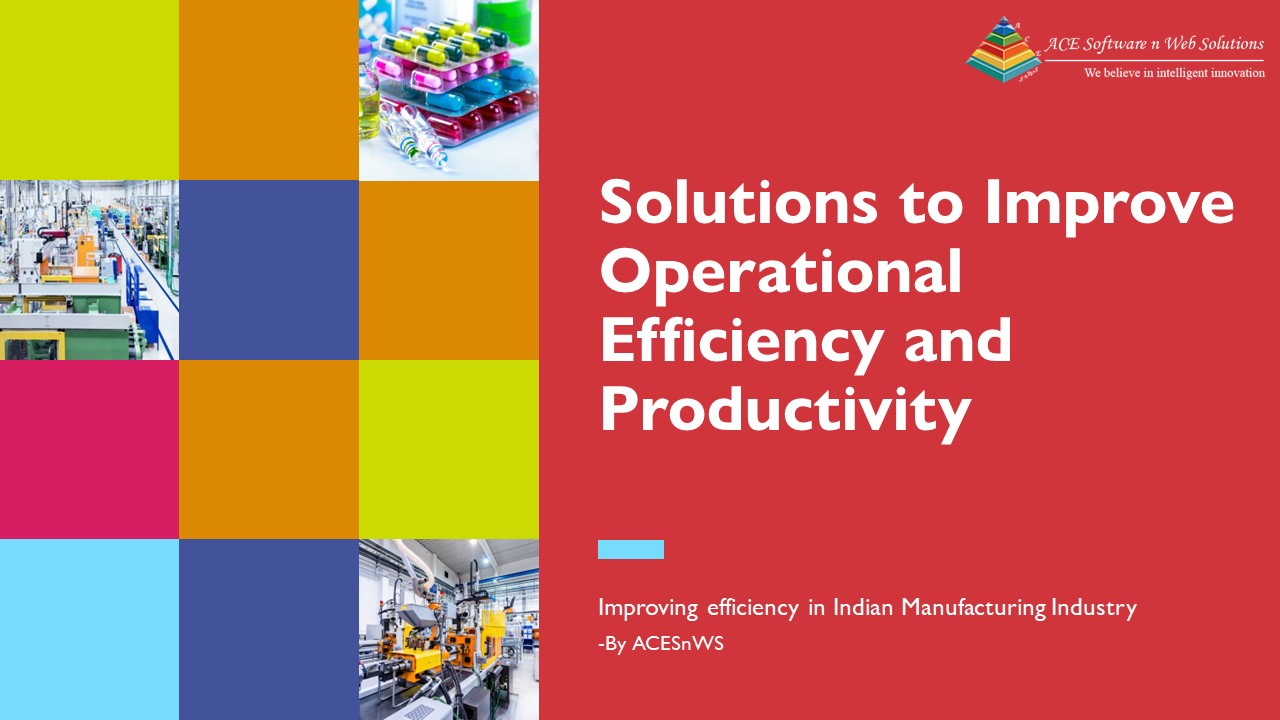
Improving efficiency in Indian Manufacturing Industry- Top 7 Solutions
Improving efficiency in Indian Manufacturing Industry for CEOs of manufacturing companies in India with turnovers ranging from 10 crore to 50 crore INR as they face several challenges in operational efficiency and productivity. These challenges can have significant impacts on their businesses. Here, we will discuss these impacts and propose detailed solutions.
Impact of Operational Efficiency and Productivity Issues
- Increased Costs:
- Wasted Resources: Inefficient operations lead to higher consumption of raw materials, energy, and labor, driving up costs.
- Higher Inventory Costs: Poor productivity can result in excess inventory, increasing storage and handling costs.
- Production Delays: Inefficiencies often lead to delays, which can cause missed deadlines, rush orders, and increased overtime costs.
- Reduced Competitiveness:
- Lower Profit Margins: Increased costs reduce profit margins, making it harder to compete on price.
- Quality Issues: Inefficiencies can lead to quality problems, damaging the company’s reputation and leading to returns and rework costs.
- Customer Dissatisfaction:
- Delayed Deliveries: Inability to meet delivery timelines can result in lost orders and dissatisfied customers.
- Inconsistent Quality: Variability in product quality can erode customer trust and loyalty.
- Employee Morale:
- Overwork and Burnout: Persistent inefficiencies can lead to overwork and burnout among employees, reducing overall productivity and increasing turnover rates.
Solutions to Improve Operational Efficiency and Productivity
- Lean Manufacturing Principles:
- Implementing Lean Tools: Techniques such as 5S, Kaizen, and Value Stream Mapping (VSM) can help identify and eliminate waste in processes.
- Continuous Improvement Culture: Foster a culture of continuous improvement where employees are encouraged to identify inefficiencies and suggest improvements.
- Automation and Technology:
- Invest in Automation: Automation of repetitive and labor-intensive tasks can significantly improve productivity and reduce errors.
- Adopt ERP Systems: Enterprise Resource Planning (ERP) systems can integrate various functions such as inventory management, production planning, and order processing, improving overall efficiency.
- Workforce Training and Development:
- Skills Training: Regular training programs for employees on new technologies, efficient work practices, and quality management can improve productivity.
- Empower Employees: Involve employees in decision-making processes and encourage them to take ownership of their tasks.
- Process Optimization:
- Streamline Processes: Analyze and redesign workflows to eliminate bottlenecks and redundancies.
- Implement Just-in-Time (JIT): JIT inventory systems can reduce inventory costs and improve cash flow.
- Quality Management:
- Total Quality Management (TQM): Implement TQM practices to ensure consistent quality and continuous improvement.
- Six Sigma: Utilize Six Sigma methodologies to identify and eliminate defects in processes.
- Data-Driven Decision Making:
- Collect and Analyze Data: Use data analytics to monitor performance, identify trends, and make informed decisions.
- KPIs and Metrics: Define key performance indicators (KPIs) to measure efficiency and productivity, and regularly review these metrics.
- Supply Chain Optimization:
- Vendor Management: Develop strong relationships with reliable suppliers to ensure timely delivery of quality materials.
- Inventory Management: Use techniques like ABC analysis and safety stock calculations to optimize inventory levels.
Case Example
Shakti Manufacturing Pvt. Ltd.
Challenges:
- High production costs
- Frequent production delays
- Quality issues leading to customer complaints
Solutions Implemented:
- Lean Manufacturing: Implemented 5S and Kaizen events to streamline operations.
- Automation: Invested in automated assembly lines and robotic arms for repetitive tasks.
- ERP System: Deployed an ERP system to integrate and manage all business processes.
- Training Programs: Conducted regular training for employees on new technologies and best practices.
- Quality Management: Adopted Six Sigma to reduce defects and improve quality consistency.
Results:
- Cost Reduction: Achieved a 15% reduction in production costs.
- Improved Delivery Times: Reduced production delays by 30%.
- Enhanced Quality: Customer complaints due to quality issues dropped by 50%.
- Employee Satisfaction: Higher employee engagement and lower turnover rates.
By addressing the issues of operational efficiency and productivity through strategic investments and process improvements, manufacturing companies can significantly enhance their competitiveness and profitability.


